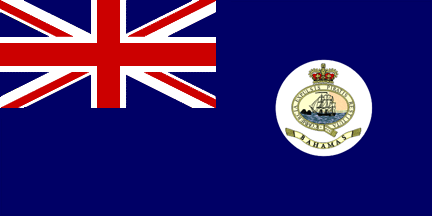
Blue Ensign
image by Martin Grieve, 8 May 2008

Last modified: 2008-07-26 by dov gutterman
Keywords: bahamas | colonial badge | crown | lighthouse | sombrero | crooked island |
Links: FOTW homepage |
search |
disclaimer and copyright |
write us |
mirrors
See also:
The Bahamas badge was introduced in 1869 and changed little
before being discontinued in 1973. The crown in the Variants is not the pattern usually seen on flag
badges. Before 1904 it would probably have been an angular
flat topped crown; from 1904 to 1953 a more domed Tudor crown,
and after 1953 a St.Edward’s crown. Until 1964 the shape of
the badge, excluding crown and scroll, was horizontally oval, but
was then made more circular and larger, relative to the
ensign. On the Blue Ensign it was on a white disc until
1923.
Officially there was no Red Ensign, but many were in use
unofficially by the 1930s, and in 1962 the Port Director of
Nassau estimated that there were probably over 1,000 defaced Red
Ensigns being flown by yachts at the time, and that more than
5,000 yachts had the ensign, and would have flown it at some time
in the past. The Colonial Office wrote to the Bahamian
government: "We realise that the unauthorised wearing of the
defaced Red Ensign in both the Bahamas and Bermuda has become so
widespread that there seems no possibility of bringing about its
discontinuance without the creation of much ill-feeling, and do
not therefore intend taking action against those concerned.
On the other hand, the Board of Admiralty has again ruled that
the present misuse of the defaced Red Ensign cannot be
regularised." [Bahamian Symbols by Whitney Smith in
Flag Bulletin March-June 1976]
David Prothero, 2 August 2001

Blue Ensign
image by Martin Grieve, 8 May 2008
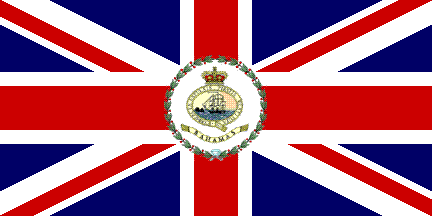
Flag of Governor when afloat
image by Martin Grieve, 8 May 2008
1869.gif)
Badge approved in 1869
image by Martin Grieve, 8 May 2008
This flag has the Victorian Crown, which was used until about
1902, even though this crown was phased out since 1880. The crown
image is based on a drawing presented by Jarig Bakker and
following the colors of the other crowns at Jaume Olle's website.
Blas Delgado Ortiz, 9 September 2001
Bahamas used circular seal in garter in 1869 flag.
David Prothero, 8 April 2005
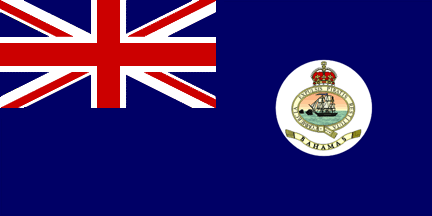
Blue Ensign 1904-1923
image by Martin Grieve, 9 May 2008
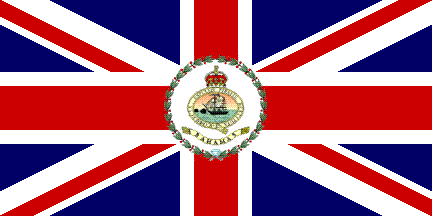
Flag of Governor 1904-1953
image by Martin Grieve, 9 May 2008
1904.gif)
Badge 1904-1953
image by Martin Grieve, 9 May 2008
For image from the National Geographic click here.
A large and two small ships within a garter surmounted by a
crown constitute the principal device of the badge of the
Bahamas. On the garter are words which tell us that the pirates
have been expelled and that business has been resumed.
This badge is the basis of the coat of arms
the country adopted on independence. They replaced the old Latin
motto with a much more anodyne one in English.
Roy Stilling, 19 February 1996
This is the colonial badge that was used on Bahama Blue ensign
in 1904-1953. It replaced old crown (1869-1904) and was replaced
with the new crown (1953-1964) and newer redention (1964-1973)
Jaume Olle', 5 September 2001
The Victorian Crown was replaced by the Imperial or Tudor
Crown, introduced by King Edward VII around 1904.
Blas Delgado Ortiz, 9 September 2001
Following the standardisation of representations of the crown
instituted by King Edward VII in 1901, the Tudor crown replaced
the original crown in 1904.
David Prothero, 9 May 2008
A 1919 Colonial Office survey of flags flown in the colonies
revealed that the Bahamas Blue Ensign was used only by the
Circuit Magistrates and was known as the Magistrates Flag, while
the British Customs Blue Ensign was used by Out-Island
Commissioners, and known as the Revenue Flag. A coloured sketch
of this flag by the Civil Engineer, W.Miller, showed that the
flag had a 3/5ths breadth angular St Edward's crown probably
dating from the 19th century. All flagstaffs flew the Union Jack.
[National Archives (PRO) ADM 116/1847B]
David Prothero, 9 May 2008

Blue Ensign 1923-1953
image by Martin Grieve, 9 May 2008
The same badge but without the white circle.
Blas Delgado Ortiz, 9 September 2001
In a letter dated 1 June 1921 it was proposed that the badge
on the Blue Ensign should be displayed directly on the fly
without a white disc. This was agreed 7 July 1921, and finally
confirmed by the Governor on 22 September 1923. [ADM
116/1847B]
1933 - In reply to a Colonial Office circular about the use of
the Blue Ensign on land, it was stated that there was no
distinctive land flag for government buildings except for the
Union Jack, or in the case of the police, a blue flag with the
police badge or words. The Bahamas Blue Ensign was flown at
Session House when the Assembley were sitting. [CO 323/1222/2]
- 1938. Sir Gerald Woods Wollaston, Garter King of Arms, pointed
out that the use of the garter on the badge was incorrect. He
advised that the garter emblem should be used only as relating to
the Order of the Garter, and with no inscription upon it other
than the motto of the Order. The Colonial Office was of the
opinion that flag badges were not the responsibility of the
College of Arms. It was agreed that existing flag badges with the
garter need not be changed, but that the garter would not appear
on any new badge designs. [CO 323/1575/17 and CO 323/1641/16]
- 1941. The decision that the flag of the Governor might be flown
on land as well as at sea was welcomed by the Governor, HRH The
Duke of Windsor. Previously the Union Jack had been flown on
Government House when the Governor was in residence. [CO
323/1830/22]

Blue Ensign 1953-1964
image by Martin Grieve, 10 May 2008
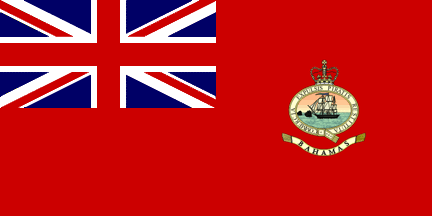
Red Ensign 1953-1964
image by Martin Grieve, 10 May 2008

Flag of Governor 1953-1964
image by Martin Grieve, 10 May 2008
1953.gif)
Badge 1953-1964
image by Martin Grieve, 10 May 2008
Tudor crown, introduced by King Edward VII, was replaced by St
Edward's crown at the beginning of the reign of Queen Elizabeth
II.
Blas Delgado Ortiz, 9 September 2001 and David
Prothero, 10 May 2008
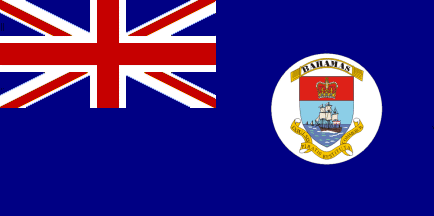
"Constitution Flag" of 1964
image by Blas Delgado Ortiz, 9 September 2001
![[Colonial badge 1959]](../images/b/bs-1959.gif)
Arms of 1959
image by Jaume Olle'
In 1959 a new shield was granted to Bahamas and the old badge
became obsolete. The new shield was included in the Blue Ensign
(I don't know if in a white circle or directly in the blue
field).
Jaume Olle', 4 May 1997
This was the "Constitution Flag" of 1964. The new
1964 flag badge was not approved until December 1963 and flags
with the new badge were not ready in time for the celebration of
internal self-government at the beginning of 1964. What became
known as Constitution Flags were produced purely for the
celebrations. The Red Ensign version did not have the
scroll 'Bahamas' above the shield. [Bahamian Symbols by Whitney
Smith in Flag Bulletin March-June 1976].
Arms, consisting of just a shield and a motto, were granted
to the Bahamas, 5 June 1959. The image is the shield
of the Arms. It did not replace the badge on the ensigns.
David Prothero, 11 May 2008
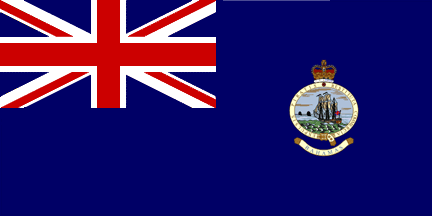
Blue Ensign 1964-1973
image by Martin Grieve, 10 May 2008
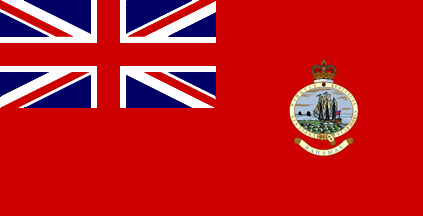
Blue Ensign 1964-1973
image by Martin Grieve, 10 May 2008
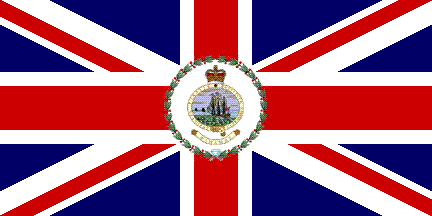
Flag of Governor 1964-1973
image by Martin Grieve, 10 May 2008
1964.gif)
Flag of Governor 1964-1973
image by Martin Grieve, 10 May 2008
The badge was revised by the College of Arms in 1963 following
a grant of Arms in 1959.
David Prothero, 11 May 2008
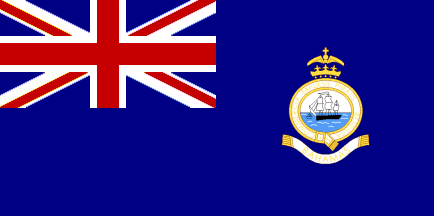
blue ensign
image by Blas Delgado Ortiz, 2 August 2001
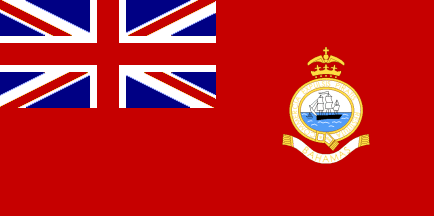
red ensign
image by Blas Delgado Ortiz, 2 August 2001
col.gif)
Badges
image by Blas Delgado Ortiz, 2 August 2001
Those images are based on photos
of a red ensign taken by Dov Gutterman at a flag display
in ICV 19 (York, July 2001). The origilal flag is from Bruce
Berry collection. According to the display catalouge:
"The moto redas: "With the expultion of the Pirates,
Commerece was restored". In the 17th and 18th centuries
pirates ravaged the Caribbean Sea."
These two versions may have been unofficial or their origins are
not clear.
Blas Delgado Ortiz and Dov Gutterman, 2 August
2001
Here is a part of a
photo taken on the family yacht at Bimini in the summer of
1963. It shows a Bahamian "courtesy"
colonial flag which isn't exactly like anything above. This may
be one of those "unofficial variants".
Don C. Warrington, 7 April 2007
The photoi is a little blurred, but it seems to me that this
is an unofficial red ensign dating from somewhere between 1953
and 1964. There is something similar image by Roberto Breschi in Bandiere.
Please note that the dates given for flags in Bandiere are often
at variance with the dates given above.
Peter Johnson, 19 June 2007
Peter is correct except for the dates. Bahamian red ensigns
were very common and in my experience, the badge always appeared
on a disk on ensigns seen in Bahamian and Floridian waters right
up through independence. I have a sample of each in my
collection.
I believe that the photo is of a Bahamian red ensign, badge on
disk, probably american manufactured.
Clay Moss, 19 June 2007
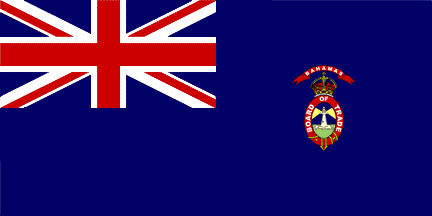
image by Martin Grieve, 30 March 2008
.gif)
the badge
image by Martin Grieve, 30 March 2008
Overseas lighthouses were the responsibility of the Imperial
Lighthouse Service of the Board of Trade.
The Bahamas office looked after not only the lighthouses on the
Bahamas but also that on Sombrero, a small island that was part
of the St Christopher-Nevis group of the Leeward Islands.
The tender based at Nassau flew a Blue Ensign with a badge that
consisted of a lighthouse within an oval belt on which BOARD OF
TRADE was written in white on red. The belt was surmounted by a
crown, with a red scroll above, bearing the word BAHAMA in
white. This was an official flag warranted 20 July
1898. It was more usual for colonial lighthouse tenders to
fly the Board of Trade Blue Ensign with the sailing ship badge.
The Bahama/Sombrero badge was flown by the tender Ana Patricia
until about 1971 when it was replaced by the Board of Trade Blue
Ensign [Bahamian Symbols by Whitney Smith in The Flag Bulletin
XIV:2-3], but the lighthouse at Sombrero, on special occasions,
flew the Wheel and Anchor Blue Ensign of the Ministry of
Transport, which had taken over the Board of Trade's transport
responsibilities in, I think, the early 1950's [Public Record
Office document MT 45/580].
David Prothero, 18 November 2000
My images are based on the Flaggenbuch (1992 re-print).
Martin Grieve, 30 March 2008
An article by Gail Saunders in "The Nassau Guardian"
(no date given) introduces Crooked Island, one of the southern
Bahamas islands. Crooked Island was visited by Colombus on 21
October 1492 and settled by Loyalists in the late 1780s. Cotton
plantations were set up but abandoned in 1803 because of a bug.
In the late XVIIIth century, the "considerable
settlement" of Pitts Town was laid out on the western shore
of the island. In the early XIXth century, it was a monthly mail
station for boats sailing between Europe and Jamaica. In the
"Bahamas Handbook", Mary Moseley writes that
"the post office mail boat flew a red flag with
a white horse in it."
Source: <www.thenassauguardian.com>.
Ivan Sache, 22 November 2006